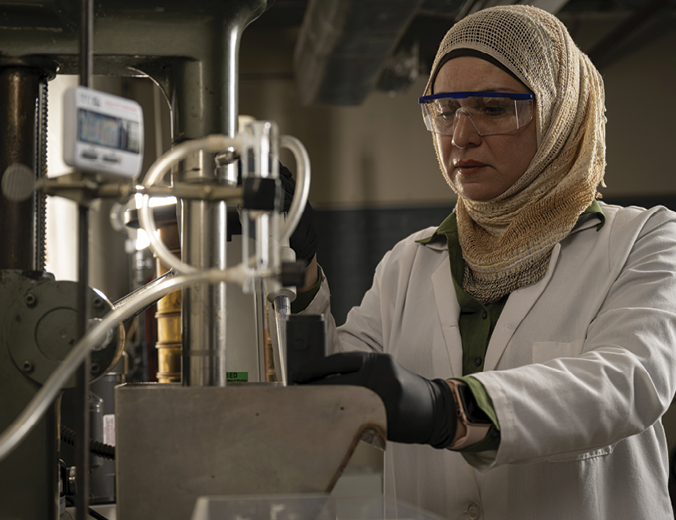A Missouri University of Science and Technology (Missouri S&T) professor has been awarded $875,000 from Rio Tinto for a two-year project to examine new techniques to recover critical minerals in the waste byproducts from copper extraction and refining.
“Our project will test new chemical dissolution strategies and purification techniques to produce pure gallium and germanium compounds from these waste materials,” said Dr. Lana Alagha, a Robert H. Quenon Associate Professor of Mining Engineering. “The new chemicals, or functionalized ionic liquids, we will use were designed specifically for this type of purpose.”
Alagha and one of her former Ph.D. students, Dr. Mostafa Khodakarami, were recently awarded patents for these chemicals, which Alagha says will work well due to their ability to effectively separate specific components from the materials.
Alagha said gallium and germanium are important elements due to their multiple uses with semiconductors, microchips, optics, health care and pharmaceuticals, and other high-tech applications.
The federal government considers both elements to be critical minerals. The Energy Act of 2020 defines critical minerals as non-fuel minerals vital to the nation’s economic or national security.

“There is currently little-to-no production of these two elements in the United States, and we rely to an alarming extent on importing them,” Alagha said. “If successfully implemented, our research could lead to a much stronger domestic supply of these important resources.”
She said recovering gallium and germanium from the wastes created when processing copper is an unconventional approach, but this type of out-of-the-box thinking is necessary for the U.S. to have a more resilient supply of critical minerals.
Both gallium and germanium are more often recovered as a byproduct of other metal refining process, such as with aluminum, zinc and lead, but Alagha said it should be possible to recover both of the elements with the chemical compounds she will develop to dissolve the waste products and with the new purification techniques she will test after that.
Alagha is a member of Missouri S&T’s Mining Engineering faculty, but she is also an expert in the field of chemistry as well, having earned a Ph.D. in Materials Chemistry from the University of Texas at Dallas.
She said she looks forward to working directly with Rio Tinto as an industry partner for this project.
“Industry partnerships help bridge the gap between theoretical knowledge and practical application,” she said. “They help facilitate the transfer of knowledge, technologies and innovations from academia to industry and vice versa. Working with Rio Tinto will help take my research in this area to the next level.”
Dr. Saskia Duyvesteyn, Rio Tinto’s chief advisor of research and development, said her organization appreciates having this relationship with S&T.
“Rio Tinto is constantly looking for better ways to extract critical minerals from our byproduct streams,” she explained. “After starting production of tellurium in 2022, we are excited to explore new techniques to produce gallium and germanium compounds in partnership with Dr. Alagha and Missouri S&T. Demand for these critical minerals used in high-tech applications is only going to grow, and we are proud to support efforts to increase domestic production.”
Alagha’s co-principal investigators from Missouri S&T for this project are Dr. Michael Moats, chair and professor of Materials Science and Engineering, and Dr. Marek Locmelis, associate professor of Geosciences and Geological and Petroleum engineering at S&T and faculty fellow in Research and Innovation.
Alagha is also involved in multiple other projects focusing on mineral recovery using unconventional sources. One project, with over $700,000 in funding through the Critical Materials Innovation Hub led by Ames National Laboratory, also focuses on extracting gallium and germanium, while another $375,000 project funded by the National Renewable Energy Laboratory focuses on recovering tellurium, gold and silver.
